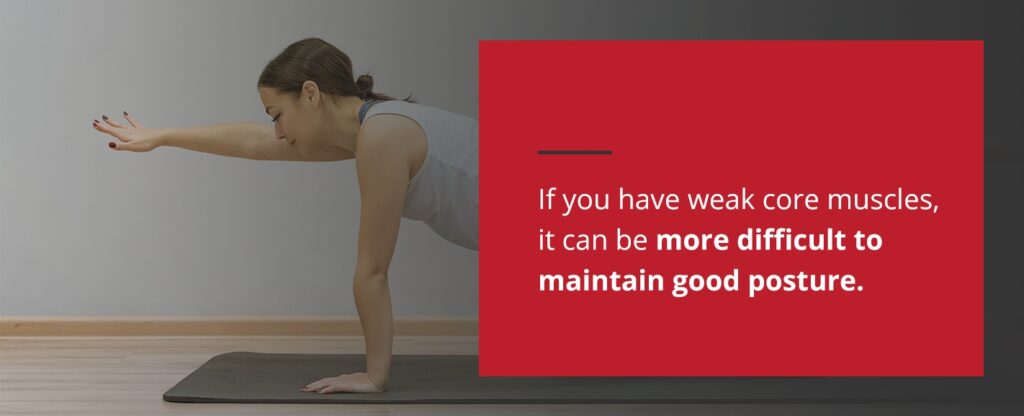Chronic back pain can impact your life and make it challenging to keep up with the demands of family, work and social activities. The National Institute of Neurological Disorders and Stroke (NINDS) defines chronic back pain as “pain that continues for 12 weeks or longer.” Back pain can be caused by a vast range of issues, including skeletal irregularities, traumatic injury or muscle spasms. If you’re experiencing nagging back pain that won’t go away, you’re not alone. According to NINDS, about 20% of people with acute lower back pain eventually develop chronic back pain. Overall, back pain is one of the most common reasons people go to the doctor or miss time at work, and it can affect anyone at any age — including children. Many of the conditions that cause back pain happen over time. These conditions such as disc damage, arthritis, or misalignment can often be pain free for years before finally causing pain. Fortunately, you can try several back pain remedies at home. However, you should also visit a chiropractor to find the cause of the problem and for relief for chronic symptoms. Here’s how to relieve back pain and feel like yourself again:
1. Watch Your Posture
Poor posture can lead to weak back muscles or put excessive strain on them, making pain worse. Posture describes how you position your body when you stand, sit or lie down. The good news is you can improve your posture and potentially alleviate back pain, even if you’ve had posture problems for many years. Correcting your posture will take some practice, but it can replace your old way of positioning your body after time. Here are a few tips to help you get started:
- Don’t slouch: Make sure you sit straight with your shoulders relaxed, feet flat on the floor and your body against the back of your chair. If you need more support for your lower back, try placing a pillow between your back and chair. Avoid sitting in the same position for too long.
- Stand tall: Stand tall and straight with your shoulders pulled back, knees slightly bent and your feet about shoulder-width apart. Keep your head level and let your arms hang naturally at your sides.
- Sleep on your back or side: Sleeping on your stomach puts pressure on your back and neck and makes it hard to maintain good posture. If you can, try sleeping on your back or side instead. When you sleep on your back, place a pillow beneath your knees to relieve back pain. If you turn into a side sleeper, try placing a pillow between your legs to keep your spine in a natural position.
- Watch your screen time: Both at work and at home, screen time can really add up. Most teenagers spend 8 or more hours a day looking at a device. As adults, even we are guilty of spending 3-4 hours a day on many days. It adds up even more if you look down at your job – over time this posture can cause permanent damage to your spine and increase the rate of decay and degeneration.
2. Move Your Body
Exercise can seem challenging when you have back pain, but It’s important to stay active. Physical activity and exercise increase blood flow to the soft tissues in your back, helping your body heal and reduce stiffness. Exercise also increases your body’s production of endorphins, which can be a natural alternative to medication for chronic back pain relief. Try to include aerobic exercise into your daily schedule and do activities you enjoy. Exercises like walking, biking or swimming can all help with lower back pain. At work, taking a short 2 minute break every hour to get up and move around can be very helpful.
3. See a Chiropractor for Back Pain
Instead of living with pain or popping medicine daily – if you’re looking for natural remedies for back pain, consider visiting a chiropractor. Chiropractors are trained to effectively relieve back and neck pain using manual manipulation to move joints in your spine and realign the bones. A chiropractor can also suggest ways to improve your posture or resolve the causes of your back pain. Patient satisfaction is extremely high for chiropractic care for back pain. Whether you were in a car accident, sit too long for work or have chronic back pain for reasons you’re not sure of, a chiropractor can often provide pain relief without the need for surgery or medications and help prevent future back problems.
4. Do Core Exercises
Core muscles are the major muscles that support and move your spine, and they’re located in your back, pelvis and abdomen. If you have weak core muscles, it can be more difficult to maintain good posture. Weak core muscles can also cause your body to rely on ligaments or spinal disks for stability, causing pain. If you strengthen your core muscles, you can reduce the strain on your lower back. If you’re a beginner, there are many exercises you can start with to strengthen your core. For example, you might try the “bridge” exercise, which requires the following steps:
- Lie on your back and bend your knees with your feet on the floor at hip width.
- Place your hands at your sides with your palms facing down.
- Tighten your core and gluteal muscles.
- Raise your hips until your knees align with your shoulders.
- Hold the position for 10 seconds to 30 seconds.
5. Switch Shoes
Wearing the wrong pair of shoes can put stress on your back and cause pain. For example, high heels can throw your body out of alignment and strain your back, and flip-flops are flat and unsupportive and can lead to back pain. Any pair of unsupportive or uncomfortable shoes can cause a chain reaction affecting your knees, hips and back. If your shoes are causing back pain, consider switching to footwear that fits properly and provides good support. Some doctors will also suggest orthotics for better support of your feet. Custom orthotics can be fitted by your chiropractor to help support your feet which is a significant factor in chronic back pain. The back will constantly have to make up for any difference in the length of the legs and can lead to significant back spasms and pain.
6. Update Your Workstation
An improperly set up workstation can lead to poor posture and back pain. You can use ergonomic principles to rearrange your workstation and make it more comfortable. According to the Mayo Clinic, proper office ergonomics include the following:
- Use an adjustable chair that supports your spinal curves and allows you to keep your feet flat on the floor.
- Place frequently used objects close to your body to minimize reaching.
- Keep your wrists straight, hands at or slightly below your elbows and your upper arms close to your body when typing or using a mouse.
- Make sure your monitor is right in front of you with the top of the screen at or a little bit below eye level.
If your job involves lifting, always squat and use your legs rather than your back for picking up objects. Ask for help or use equipment to lift or move very heavy objects. A standing workstation has also been shown to be a great idea for posture and pain relief. Your doctor can evaluate you to see if a standing workstation would be helpful to you.
7. Get Adequate Sleep
According to a study published in Anesthesiology Clinics, sleep disturbances can exacerbate pain, and chronic pain can also cause sleep issues. While it may not be easy to get quality sleep with back pain, it’s still essential to get 7 hours to 9 hours of sleep per night. The key to good sleep and reducing back pain is to ensure you’re comfortable and you keep your back aligned. Make sure you have a supportive and comfortable mattress and pillows to help keep your neck and back in a straight line. If you continue to have issues sleeping or waking up with back pain, speak to a doctor and make sleep a priority.
8. Do Activities That Make You Happy
Back pain can lower your mood and make it hard to enjoy life’s pleasures. It helps to do activities that relieve stress and be around people who make you smile. According to NINDS, stress can cause muscle tension and increase the chance of experiencing back pain. Therefore it’s worth it to include even a few things in your daily schedule that bring you joy, whether that be enjoying a cup of relaxing tea or hugging a loved one. Laughter can be a simple home remedy for back pain. Laughter can boost your mood, relieve muscle tension and cause your body to produce endorphins for natural pain relief.
What to Do if Your Back Still Hurts
If you’re wondering how to reduce back pain, it’s best to reach out to a professional. At Thrive Chiropractic Group we’re ready to help you feel better. Thrive Chiropractic Group is a team of doctors dedicated to providing chiropractic solutions to individuals and families in the Oklahoma City region. If you’re suffering from chronic back pain, we can help you find long-term relief and enhanced well-being overall. You deserve to feel good every day. Don’t let back pain prevent you from thriving. Call Thrive Chiropractic Group or fill out our online form to schedule your appointment today.



